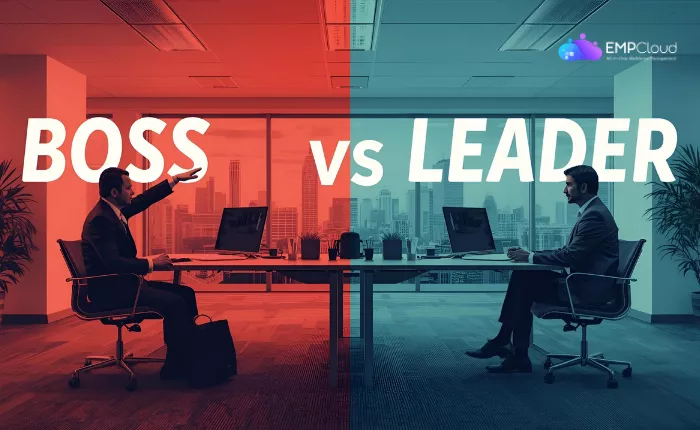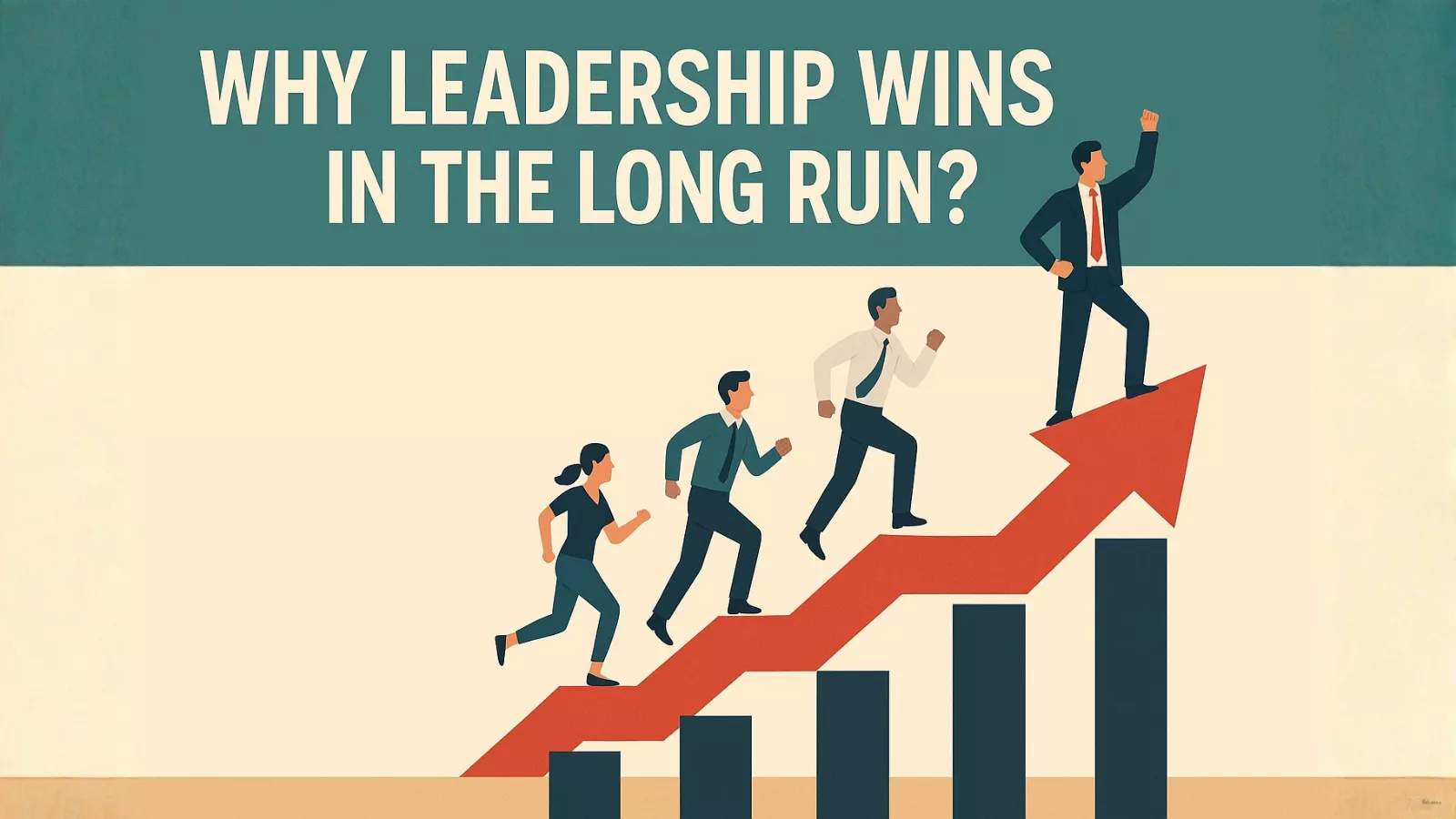
Every organization has people in charge, but not all of them truly lead. Some manage through authority, others guide through inspiration. The contrast between a boss vs leader defines how teams grow, perform, and stay motivated. A boss gives orders; a leader gives purpose. This difference may sound subtle, but it shapes how people feel, work, and succeed together.
Let’s explore what separates a boss from a leader, how their mindsets affect the workplace, and what you can learn to shift from managing to leading effectively.
In a hurry? Listen to the blog instead!
What Is The Core Difference Between A Boss And A Leader?
 A boss drives tasks, deadlines, and discipline. A leader drives energy, creativity, and commitment. While both aim for success, their methods differ drastically. The key difference between a boss and a leader lies in intention—bosses focus on outcomes, while leaders focus on people.
A boss drives tasks, deadlines, and discipline. A leader drives energy, creativity, and commitment. While both aim for success, their methods differ drastically. The key difference between a boss and a leader lies in intention—bosses focus on outcomes, while leaders focus on people.
The boss vs leader debate isn’t about who’s right or wrong; it’s about recognizing what inspires long-term success. Bosses often rely on structure and control, while leaders build trust and collaboration. Understanding this difference is the first step toward leading teams that perform because they want to, not because they have to.
Next, let’s dive deeper into the defining traits that set the two apart in daily work life.
Key Differences Between A Boss And A Leader
 The differences between a boss and a leader go far beyond job titles. They’re rooted in behavior, mindset, and values that shape how people experience leadership.
The differences between a boss and a leader go far beyond job titles. They’re rooted in behavior, mindset, and values that shape how people experience leadership.
1. Vision Over Control
A boss often focuses on maintaining order, ensuring that tasks are completed as planned. A leader, however, paints a vision that excites others to contribute beyond their roles. Instead of commanding action, leaders inspire it. When teams understand the “why,” they commit to the “how.”
This shift from control to vision makes all the difference in how employees show up each day. It sets the tone for creativity and problem-solving—two elements that make leadership sustainable.
2. Collaboration Over Command
Bosses assign responsibilities; leaders share ownership. A true leader believes success comes from working with the team, not above it. They value every idea, listen actively, and encourage healthy discussions.
When collaboration becomes the norm, productivity doesn’t just rise—it becomes more meaningful. Employees start viewing their roles as contributions to something bigger. That’s how the boss vs leader dynamic begins to transform the workplace.
3. Growth Mindset Over Fixed Mindset
Bosses often feel the need to “know it all.” Leaders embrace the fact that learning never stops. They actively seek feedback, welcome new perspectives, and push for innovation. This growth mindset creates an environment where curiosity thrives, and mistakes are seen as lessons, not failures.
A leader who learns alongside their team builds credibility and respect. That mindset doesn’t just improve performance—it builds a culture of continuous improvement.
4. Accountability Over Blame
One of the biggest differences between a boss and a leader is how they handle failure. Bosses tend to find fault; leaders find solutions. A boss might say, “Who made this mistake?” while a leader asks, “How can we fix this together?”
Taking responsibility creates psychological safety—a key ingredient for team trust. When leaders own both the wins and losses, people feel safer taking initiative without fear of being blamed.
5. Inspiration Over Intimidation
Authority can make people follow orders, but inspiration makes them believe. Leaders know that empathy drives effort far better than fear. They motivate through encouragement and appreciation rather than criticism or threats.
This kind of influence doesn’t just deliver results; it builds loyalty. Teams led by inspiring leaders tend to stay longer, contribute more, and grow faster.
With these traits in mind, it’s worth pausing to assess your own approach.
Self-Reflection: Are You Acting Like A Boss Or A Leader?
 Every professional, at some point, faces this question—am I managing or truly leading? Reflecting on your approach can reveal where you stand in the leader vs boss spectrum.
Every professional, at some point, faces this question—am I managing or truly leading? Reflecting on your approach can reveal where you stand in the leader vs boss spectrum.
Ask yourself:
- Do I listen more than I speak?
- Do I empower people to make decisions?
- Do I share credit when things go right and take responsibility when they don’t?
- Do I motivate through respect rather than authority?
If you find yourself leaning toward control instead of collaboration, this is your cue to evolve. The next section explains why leadership isn’t about abandoning structure but about applying it with empathy.
When Being A Boss Works — & When It Doesn’t?
In certain moments, being a boss is necessary. When deadlines are tight or crises arise, someone must take charge quickly. A clear directive can keep operations smooth. However, staying in “boss mode” all the time creates distance between management and the team.
The boss vs leader approach should be situational. Great leaders know when to switch between authority and guidance. They lead firmly when needed but never lose empathy. This flexibility turns ordinary managers into respected mentors.
And that balance becomes even easier when the right tools support your leadership efforts.
How Empcloud Strengthens The Leader Mindset?
 Leadership in modern workplaces isn’t just about giving direction—it’s about creating connection, accountability, and clarity across every level of the organization. That’s where Empcloud, an advanced employee monitoring suite, plays a vital role.
Leadership in modern workplaces isn’t just about giving direction—it’s about creating connection, accountability, and clarity across every level of the organization. That’s where Empcloud, an advanced employee monitoring suite, plays a vital role.
Empcloud bridges the gap between boss vs leader by offering data-driven insights and tools that help organizations manage with empathy rather than control. Instead of relying on rigid supervision, it empowers leaders to guide their teams through transparency, trust, and collaboration.
As an employee monitoring suite, Empcloud goes beyond tracking productivity—it provides a complete framework for leadership-driven management. Here’s how Empcloud transforms everyday management into effective leadership:
- Employee Engagement: EmpCloud has this feature, where you can keep track of employee engagement in the workspace. Through real-time analytics, feedback systems, and participation tracking, it helps identify engagement trends and areas of improvement.
- Performance Insights: Use analytics to identify strengths and challenges early, encouraging proactive improvement instead of reactive correction—a hallmark of strong leadership.
- Recognize & Reward Excellence: EmpCloud’s Employee Appreciation feature enables management to acknowledge and reward employees for their hard work and achievements. From personalized recognition to performance-based rewards, it helps build a culture of motivation, engagement, and loyalty across the organization.
- Goal Setting and Feedback System: Align individual goals with organizational vision and provide continuous feedback to foster growth and accountability.
With these capabilities, Empcloud doesn’t just monitor—it mentors. It equips modern leaders with the tools to cultivate trust, improve engagement, and build cultures. In essence, Empcloud supports every organization striving to bridge the difference between a boss and a leader while nurturing the qualities that define true leadership.
Building A Culture That Encourages Leadership
Leadership isn’t a role—it’s a ripple effect. When leaders show trust, empathy, and clarity, others follow their example. This culture spreads organically, influencing how people communicate, solve problems, and support one another.
In the boss vs leader context, culture becomes the deciding factor. Bosses enforce rules; leaders inspire principles. Bosses demand results; leaders build commitment. A leadership-driven culture doesn’t just improve performance—it transforms how people feel about work itself.
And once such a culture takes root, the organization becomes stronger from within.
Why Leadership Wins In The Long Run?
 The short-term efficiency of a boss may drive output, but it rarely sustains passion. Leadership, on the other hand, fuels purpose. It makes people care about what they do and who they do it for.
The short-term efficiency of a boss may drive output, but it rarely sustains passion. Leadership, on the other hand, fuels purpose. It makes people care about what they do and who they do it for.
The differences between a boss and a leader are not just management styles—they represent two opposite philosophies. One enforces compliance; the other encourages growth. The long-term success of any company depends on leaders who inspire, empower, and evolve with their teams.
Leadership creates trust, loyalty, and innovation—qualities that no rulebook can enforce. That’s why modern workplaces prioritize empathy and vision over authority.
As we wrap up, let’s revisit what this journey teaches us about leadership in action.
Read More
Master Workforce Management In 2025 Like Never Before!
Conclusion
Every team deserves someone who leads with vision, listens with empathy, and acts with integrity. The conversation around boss vs leader isn’t about labels—it’s about impact. Leaders motivate from within, while bosses manage from above.
By understanding the differences between a boss and a leader, you can redefine how you connect with your team. Lead through collaboration, accountability, and inspiration. When leadership becomes personal, teams perform not just for goals—but for shared purpose.
Empcloud stands as a reminder that the right mindset and the right tools can power great leadership. The choice between being a boss or a leader is yours—but only one creates a legacy worth following.
FAQs
- Why does the boss vs leader mindset matter in today’s workplaces?
The boss vs leader mindset matters because it directly affects how teams perform and feel at work. A boss might ensure deadlines are met, but a leader creates an environment where people feel motivated, valued, and inspired to do their best. - Can someone shift from being a boss to becoming a leader?
Yes, anyone can evolve from boss to leader with self-awareness and the right approach. The boss vs leader transformation starts with listening more, empowering others, and focusing on people instead of just results. - How does the boss vs leader difference impact employee retention?
Employees are more likely to stay with organizations led by true leaders. The boss vs leader difference shows up in how teams feel supported—leaders build loyalty through trust and recognition, while bosses often rely on authority and compliance. - What are small daily actions that show leadership instead of authority?
Simple actions like asking for input, recognizing effort, or offering constructive feedback reflect a leader’s mindset. The boss vs leader balance is built through consistency—small gestures that make employees feel heard and respected. - How can technology help bridge the boss vs leader gap?
Modern tools like Empcloud make it easier to lead with clarity and empathy. Technology provides insights that help managers support their teams effectively, strengthening the shift from boss vs leader thinking to leadership-driven culture.


